2019 Building America Report Menu
Delivering an Excellent Customer Experience
Union Pacific moves the goods families and businesses use every day, including the food we eat, the cars we drive, the chemicals to clean our water, and the steel and lumber to build our communities. Our roughly 10,000 customers, large and small, depend on us to deliver their products in a safe, reliable, fuel-efficient and environmentally responsible manner.
In an era when making a purchase is as simple as one click and shipments can be tracked in near-real time on a phone, we are working to provide an excellent customer experience that meets these demands. Union Pacific regularly asks customers to provide feedback, which, in turn, helps us meet their evolving needs.
- What We Carry
- Responding to Customer Needs
- Unified Plan 2020's Customer Impact
- Leveraging Technology to Support Customers
- What's Ahead
Located just 12 miles outside downtown Dallas, our Dallas Intermodal Terminal supports intermodal volume across the region.
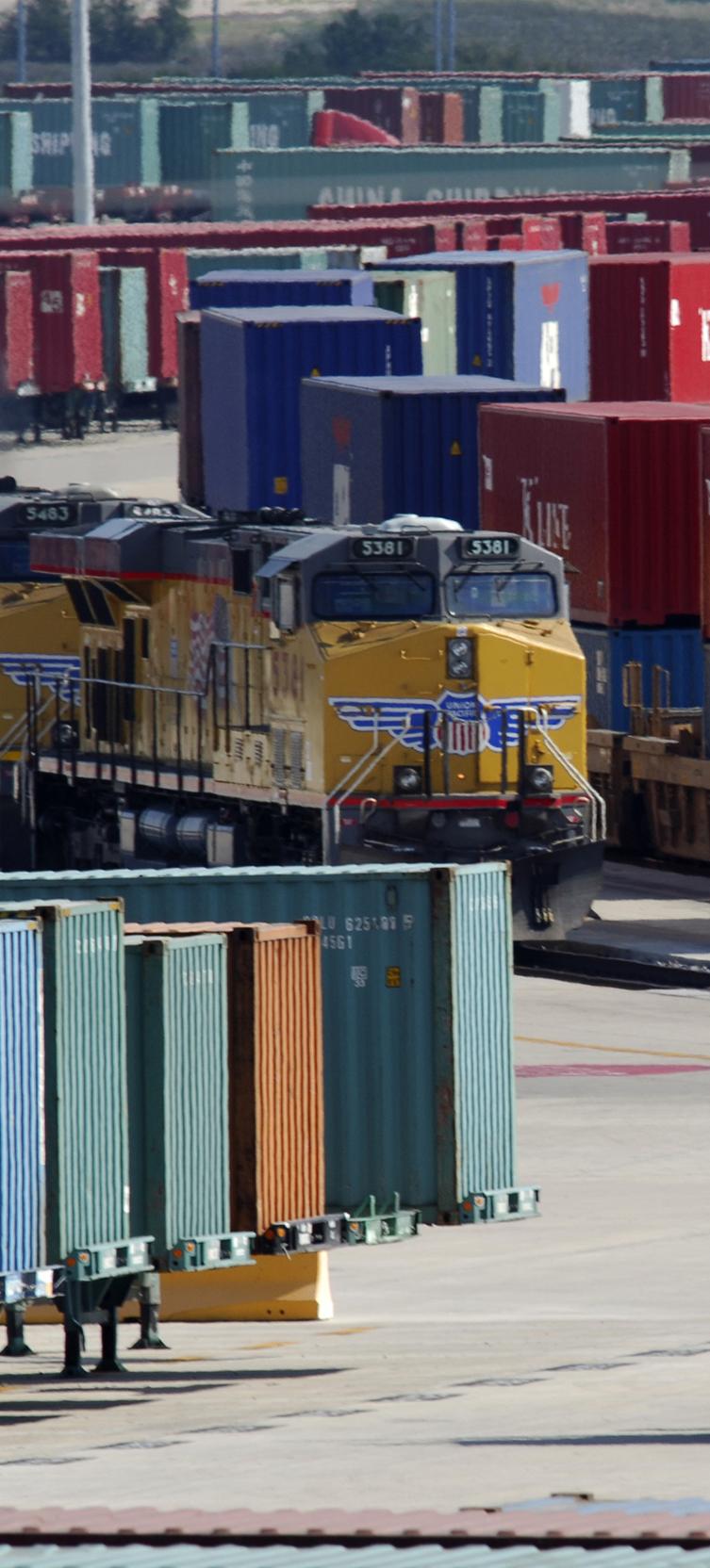
What We Carry
Our railroad directly serves many of the fastest growing cities in the U.S. and connects the country’s global supply chain at all major West Coast and Gulf Coast ports to Canada, Mexico and the country’s eastern gateways. Approximately 40% of our freight originated or terminated outside of the U.S.
Our Diversified Commodity Mix
Agricultural ProductsIf it's on your table, chances are it traveled by train to get there. Beer, flour, tomato paste, potatoes, cheese – we transport the food that feeds the nation and many other parts of the world.
Energy
We transport the energy products that power homes, schools and businesses – coal, LPG, petroleum products, renewable energy products, wind turbines and sand for drilling.
Industrial
We carry a variety of raw materials and finished goods, including the lumber, steel, cement, pipe and plastics used to construct communities and build roads.
Premium
Our wide range of multi-modal transportation solutions offer truck-competitive rates and service schedules for domestic and international intermodal shippers, moving products such as electronics, toys, furniture and clothing. We also deliver finished vehicles and automotive parts.
Mexico Markets
We are the leading freight transportation service provider between the U.S. and Mexico, and the only railroad serving all six major Mexico gateways. Cross-border traffic with Mexico comprised about 11% of Union Pacific’s total 2019 volume.
As the needs of our customers evolve, we rise to meet them. Effective Jan. 1, 2020, Union Pacific consolidated its business groups from four to three: Bulk, Industrial and Premium. Bulk, formerly Agricultural Products, added coal, petroleum coke markets and renewables to its portfolio. Industrial added sand, petroleum and LPG markets. Premium remained unchanged. The new structure allows us to better serve customers while remaining agile to market conditions. 1
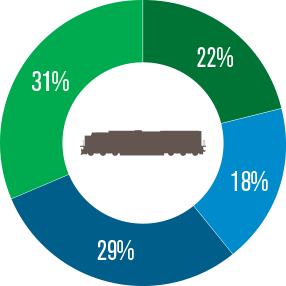
Freight Revenue
| Agricultural Products | 22% |
| Energy | 18% |
| Industrial | 29% |
| Premium | 31% |
1 A freight revenue breakdown based on the three business groups, effective Jan. 1, 2020, is available at up.com.
Loup Logistics Extends Rail's Reach

From left, Loup Logistics Managers Diane McPherson and Jeff Richardson pride themselves on finding new solutions that improve service and reliability.
Loup Logistics Company provides innovative transportation logistics services that help connect shippers to rail. A Union Pacific subsidiary, the company provides door-to-door transportation services, including transloading, warehousing, cross-border expertise, shipment visibility and supply chain optimization.
Why Transload?
Transloading means freight is transferred between truck and train along its journey from origin to destination. A single rail car can carry the same amount of product as three to four truckloads – and trains are up to four times more fuel efficient, meaning freight travels even further on a single gallon of gas. These efficiencies are built into the customers’ transportation costs, allowing them to ship heavier loads without having to lease warehouses and equipment or be located next to the tracks.
What Products Can Be Transloaded?

Household Goods
Floor tiles, boxes, parcels, shoes, clothing, toys, furniture, appliances, electronics

Oversized Items
Transformers, wind turbine blades, machinery, military vehicles

Beverages
Beer, wine, tequila, orange juice

Small Items
Sand, plastic pellets, soda ash, flour

Building Materials
Lumber, pipe, metals, paper, rebar, metal coil, bricks

Food
Packaged food, canned goods, frozen food, produce, seafood, cheese, chocolate

Liquids
Ethanol, biodiesel, diesel exhaust fluid (DEF), corn syrup, petroleum, LPG

Just About Everything Else
Paper, solar panels, waste, feed products, Christmas trees, paint, carpet, irrigation equipment, fibers, grains, minerals and so much more
Responding to Customer Needs
Developing customer loyalty takes hard work – these relationships are built on open dialogue and regular feedback. Our Customer Experience team is dedicated to understanding what’s important to our customers and responding to those needs, whether by improving a business process or finding an innovative solution.
Customer surveys allow us to track trends and analyze data. Every month, we receive evaluations from customers who interact with local Union Pacific operations through the daily management of their rail inventory. These surveys show the direct impact of achieving operational KPIs, such as First and Last Mile performance. These metrics measure whether we arrived when we said we would and left with a customers’ goods on time.
We ask the top decision-makers of companies, representing approximately 90% of Union Pacific’s book of business, for their assessment through biannual surveys; approximately 20%-30% are returned. These surveys give customers an opportunity to provide Union Pacific perspective in areas such as operational consistency, local service, sales team effectiveness, rate comparison and service issue resolution. The scores and comments are analyzed in-house to create a Net Promoter Score that helps guide our decision-making. For example, we are laser-focused on improving our response time to customers requesting pricing options. We listened to their feedback and deployed process enhancements that improved our response speed by nearly 40%. This channel is important in helping us understand how changes in our service product, as a result of Unified Plan 2020, are being experienced by customers.
In mid-2018, we developed a Customer Advisory Board, comprised of 10-15 members representing large and small businesses and a variety of commodities. We invite board members who are leaders in their industry, and can advise us on best practices and innovative ideas that, ultimately, help enhance our service product and our customers’ supply chains.
Customers asked for increased communication. We responded with additional email communications from Executive Vice President – Marketing and Sales Kenny Rocker, providing service updates and customer announcements. We also created Track Record, an online magazine, to help transportation and logistics professionals achieve accessible, cost-effective and reliable solutions. From big ideas to the basics, Track Record helps industry leaders gain the know-how to improve their supply chain’s performance. A new edition is published weekly and pushed directly to email inboxes and on social media.
Unified Plan 2020's Customer Impact
Union Pacific customers quickly adapted to change as we implemented Unified Plan 2020, an operating plan designed to move cars faster, increase asset utilization and improve service reliability. For our customers, it means more reliable, consistent and faster rail service that, in turn, strengthens their overall supply chain, as well as reduces transit time and costs.
Customers who operate unit trains were most impacted as we shifted those cars into manifest service. Manifest trains move different types of rail cars carrying a variety of freight from multiple shippers. Unit trains do not depart until every car is ready, and while this model may benefit some customers, the unscheduled nature and dwell time could require more resources and capital than the new model. Now, loaded cars can be billed and shipped without waiting for an entire train to be ready for departure. The same goes for unloading at destination. This first-in, first-out model keeps inventory, and supply chains, moving.
We know change can be difficult, but we are committed to up-front customer communication. In many cases, we had collaborative discussions resulting in innovative solutions that created mutually beneficial efficiencies.
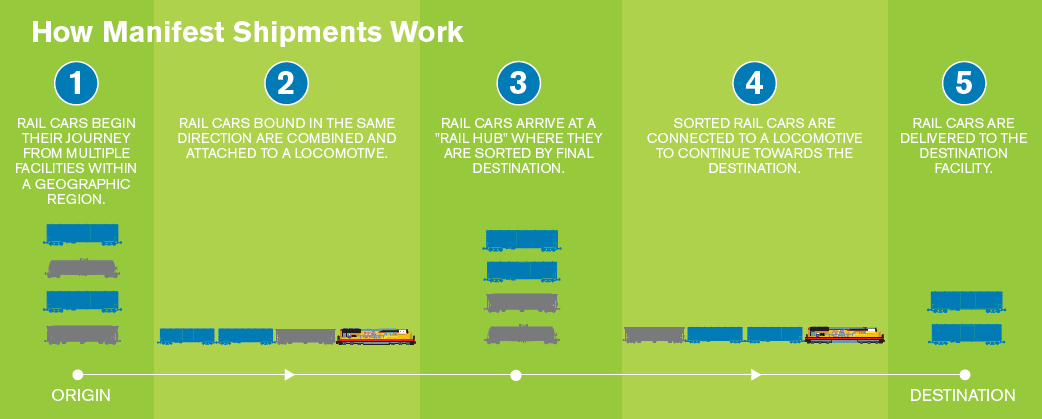
Harvesting Unified Plan 2020's Benefits

The Bulk team works to transition continuously consumed products, such as dried distiller grains, a feed ingredient produced in ethanol plants, from unit trains to manifest.
As Union Pacific focuses on moving cars rather than trains and blends existing train services, several ethanol customers are reaping the benefits. For example, a terminal in Southern California now has a constant flow of cars moving in and out. In the past, customers encountered temporary outages while the facility waited for the next unit train to arrive. A unit train carries a single commodity. This created a trickle-down effect with occasional product outages further into the supply chain.
“With manifest service, we can maintain a consistent and reliable amount of inventory in the area to significantly reduce the number of outages,” said Chris Kankousky, general director, Marketing and Sales. “With greater reliability, they’re engaging their customers for more business.”
Maxx-imizing Our Impact
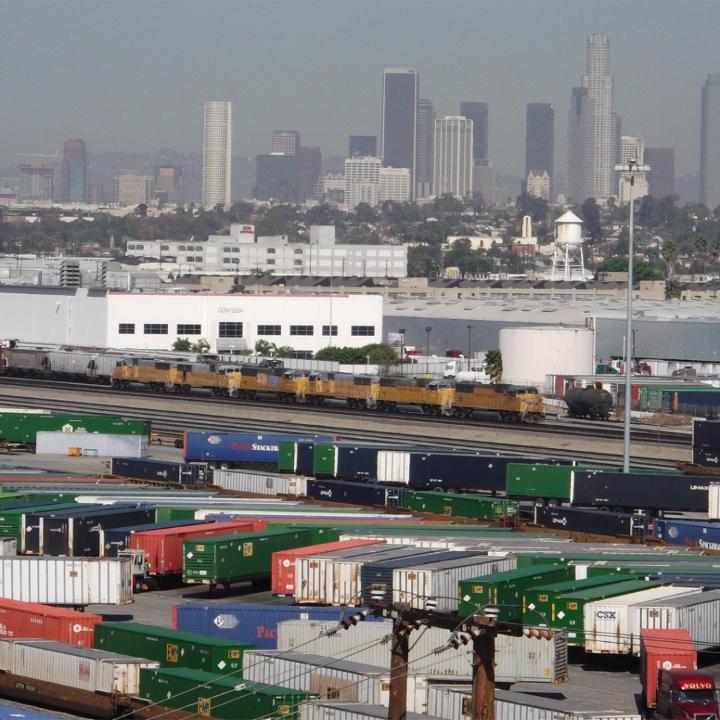
TThe majority of TJX Companies’ inventory originates out of Union Pacific’s Los Angeles, California, intermodal terminal.
TJX Companies, an international off-price apparel and home goods retailer, is a longstanding Union Pacific customer. Leveraging Unified Plan 2020 principles to move cars faster and reduce the amount of time they wait for departure, we enable TJX stores, such as TJ Maxx, Marshalls, and Home Goods to turn over inventory every three weeks. As a result, intermodal on-time performance improved 59% from October 2018 to October 2019. During the peak season in November and December, Union Pacific actively consolidated resources to prevent container shortages.
“We really try to understand our customers’ needs so we can create a mutually beneficial game plan,” said Nick Smith, senior manager, Marketing and Sales. “We believe our resourcefulness and creativity set us apart from our competitors.”
Leveraging Technology to Support Customers
Part of offering a more reliable service product is improving the customer experience, so they know what to expect and when. We’ve made excellent progress enhancing our technology to provide proactive notifications that allow customers to plan better and improve their shipping experience.
Our User Experience team meets with customers to analyze their supply chain from beginning to end, gaining an understanding of their processes and identifying gaps Union Pacific can fill with our Customer Experience tools. The team also is on hand to explain new technology and look for ways to further innovate the customer journey.
UPGO Helps Drivers Accelerate
Two years in the making, the UPGo app is now available at all 32 Union Pacific intermodal facilities. The app is designed to expedite the intermodal terminal experience for truck drivers, helping streamline access and eliminate congestion. Drivers access the app on their mobile device before terminal arrival, confirming required information — such as the waybill — is submitted.
More than 26,000 drivers are registered to use UPGo, with 67% of high-frequency drivers (those with five or more monthly gate visits) actively using the app. We’ve also added it to our 15 Automated Gate System facilities to further expedite service for truck drivers at gates with higher volumes.
Empowering Customers One Api at a Time
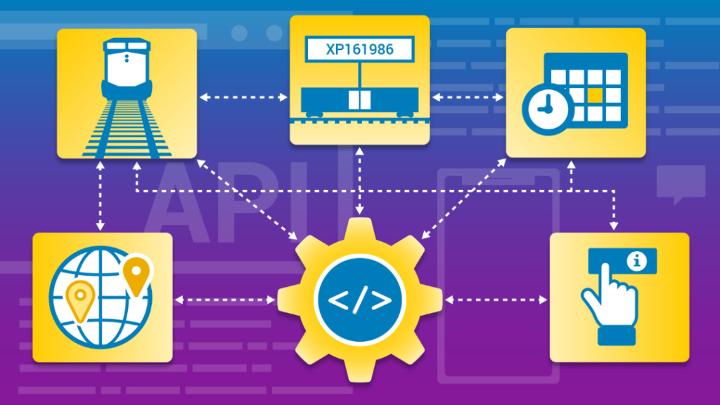
Union Pacific understands our customers use data to make decisions and manage their supply chains. We’re the first in the rail industry to invest in Application Program Interfaces (APIs), which allow our systems to connect, integrate and interact with our customers. They’re similar to travel advisor apps that allow you to track your flight, car and hotel reservations.
Beginning in late 2018 and through 2019, we piloted APIs that reduce manual work and streamline business transactions. For example, customers can integrate an API directly into their systems, which allows them to release rail equipment without having to log into our website. The idea is to put flexibility into our customers’ hands.
Each API is a building block, and we continue to work with customers to add API services. Whether customers interact with us on our website or through APIs that connect to intelligent personal assistants like Alexa, our goal is to ensure customers receive the same answers in easily digestible formats.
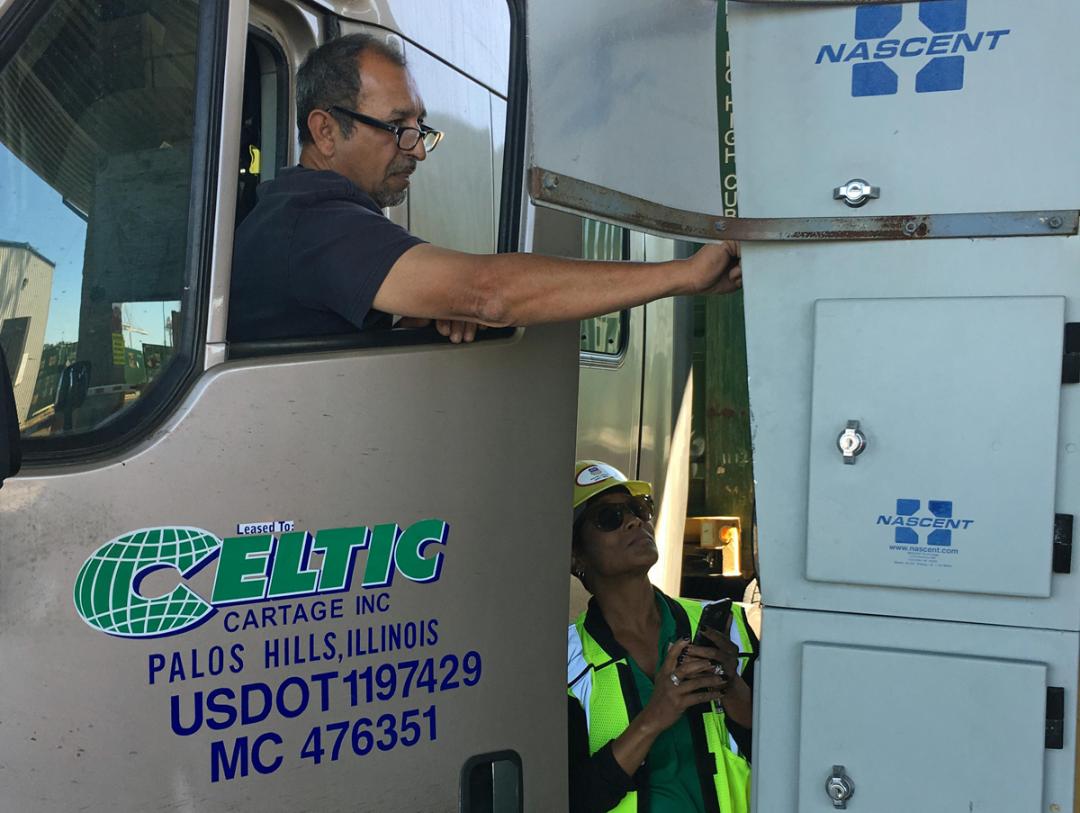
Elle Spencer, senior manager-Intermodal Operations, Premium Operations, helps a driver with UPGo in Oakland, California.
What's Ahead
We plan to conduct third-party benchmarking to help us understand how customers perceive Union Pacific, and why they use our competitors or other transportation modes. This data will help us create a short- and long-term commercial and customer experience strategy.
We’re working with our IT Department to launch an additional suite of APIs. These services will tell customers more about their shipments – account information, location and equipment details – and help us continue growing our supply chain data integrations.
